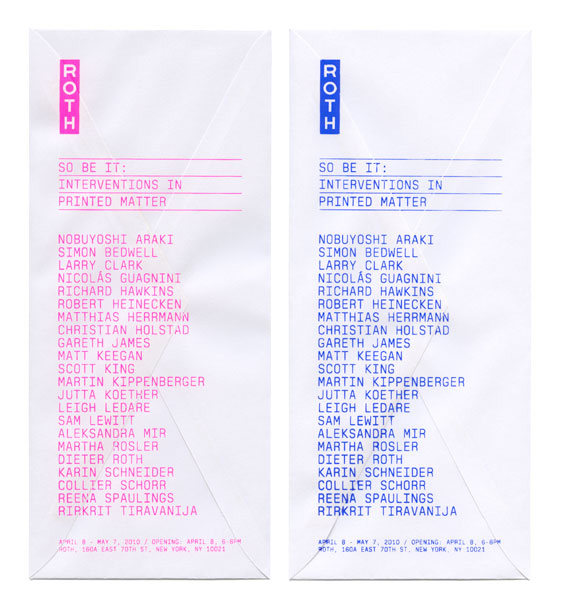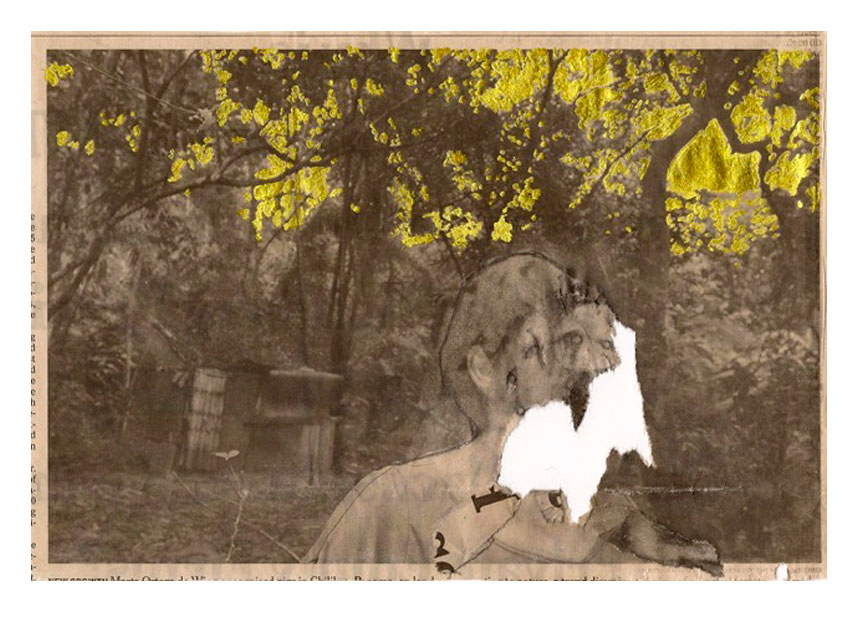So Be It: Interventions in Printed Matter
April 8 – May 7, 2010
Andrew Roth is pleased to announce the exhibition “So Be It: Interventions in Printed Matter,” which explores the diverse, and subversive, history of artist’s interventions. The show includes work by modern pioneers, such as Dieter Roth, Martin Kippenberger, Larry Clark, Robert Heinecken, and Hans-Peter Feldmann, as well as younger artists, such as Matt Keegan, Karin Schneider, Sam Lewitt, Simon Bedwell, Jutta Koether, and Nicolás Guagnini — all of whose works infiltrate, manipulate, or preempt existing printed material and hijack them for a new, often contradictory purpose.
While less sensational or provocative than its performative cousin (for example, Brian Eno urinating in Duchamp’s The Fountain in 1995), the act of print intervention is often a subtler, sometimes invisible, affair. Some artists have insinuated their works into the pages of other magazines: Dieter Roth used a free local advertising bulletin to print short aphorisms so baffling that readers called the paper to have them stopped; and Scott King used the pages of U.K. magazine Sleazenation to publish images of a football riot, with attention to the rioters’ clothing labels (“jeans by LEE”) as if it were a fashion shoot. Other artists have used printed material — in the form of books, posters, magazines, and even napkins and press releases — as the canvas on, or against, which to present their own works, from British group the Bank’s Fax-Bak project to Robert Heinecken’s overprinted magazines to Martin Kippenberger rubberstamping the word TOT (German for dead) on every page of a Robert Mapplethorpe catalog. Still others have simply taken a printed work’s format and content and scrambled them completely, as is the case of Aleksandra Mir’s feminist mishmash of the Philadelphia Inquirer, Martha Rosler’s confrontational collages, or Collier Schorr’s Jens F., for which Andrew Wyeth’s The Helga Pictures provided a template for revisionist photography.
The intervention, and the print intervention in particular, traces its history back at least to the Cubists and their incorporation of newspaper into their compositions. The collages of the Surrealists carried the work into more subversive areas, which culminated in Marcel Duchamp’s mischievous, mustachioed interpolation on La Gioconda, titled L.H.O.O.Q. The print intervention began to find its footing in earnest as conceptualists and other artists began to work more innovatively with language and the printed word, and it has only continued to grow in its popularity and usage. As Matt Keegan’s I’ll be your beard if you’ll be my mirror and its Duchampian echo make clear, artists working today are willing to apply interventionist principles to any object from any facet of modern life. The exhibition “So Be It” takes its name from a very recent example, in which Nicolás Guagnini has silkscreened in a limited edition of 7 copies a text by Dan Flavin onto the napkins designed for the DIA Foundation by Louise Lawler. The phrase suggests on the one hand a capitulation to the status quo, yet it also implies a decisiveness from which to move forward. All of the works exhibited here arise out of a “so be it” impulse, in an attempt to peel away the veneer and show an image, a word, a condition for what it is, even if it means obscuring it entirely.
Nobuyoshi Araki, the BANK, Simon Bedwell, Larry Clark, Guy-Ernest Debord and Asger Jorn, Hans-Peter Feldmann, Nicolás Guagnini, Richard Hawkins, Robert Heinecken, Matthias Hermann, Christian Holstad, Gareth James, Matt Keegan, Scott King, Martin Kippenberger, Jutta Koether, Leigh Ledare, Sam Lewitt, Aleksandra Mir, Martha Rosler, Dieter Roth, Karin Schneider, Collier Schorr, Reena Spaulings, Rirkrit Tiravanija.




